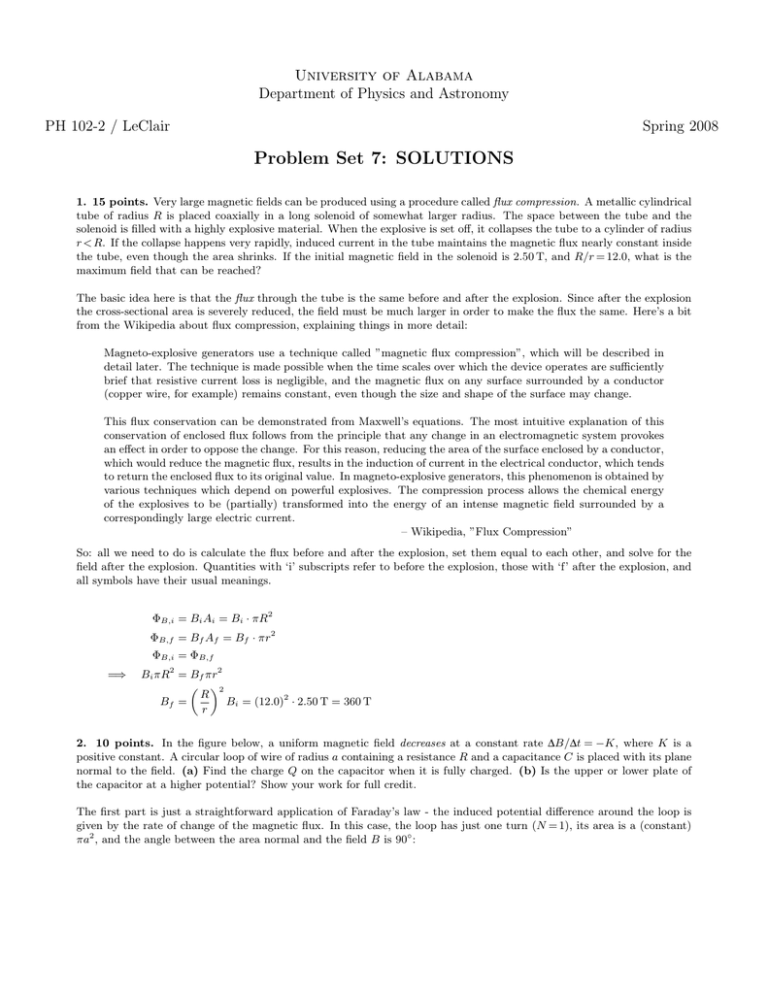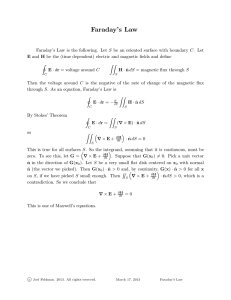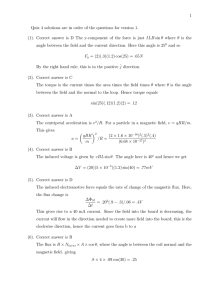Problem Set 7: SOLUTIONS - The University of Alabama
advertisement

University of Alabama Department of Physics and Astronomy PH 102-2 / LeClair Spring 2008 Problem Set 7: SOLUTIONS 1. 15 points. Very large magnetic fields can be produced using a procedure called flux compression. A metallic cylindrical tube of radius R is placed coaxially in a long solenoid of somewhat larger radius. The space between the tube and the solenoid is filled with a highly explosive material. When the explosive is set off, it collapses the tube to a cylinder of radius r < R. If the collapse happens very rapidly, induced current in the tube maintains the magnetic flux nearly constant inside the tube, even though the area shrinks. If the initial magnetic field in the solenoid is 2.50 T, and R/r = 12.0, what is the maximum field that can be reached? The basic idea here is that the flux through the tube is the same before and after the explosion. Since after the explosion the cross-sectional area is severely reduced, the field must be much larger in order to make the flux the same. Here’s a bit from the Wikipedia about flux compression, explaining things in more detail: Magneto-explosive generators use a technique called ”magnetic flux compression”, which will be described in detail later. The technique is made possible when the time scales over which the device operates are sufficiently brief that resistive current loss is negligible, and the magnetic flux on any surface surrounded by a conductor (copper wire, for example) remains constant, even though the size and shape of the surface may change. This flux conservation can be demonstrated from Maxwell’s equations. The most intuitive explanation of this conservation of enclosed flux follows from the principle that any change in an electromagnetic system provokes an effect in order to oppose the change. For this reason, reducing the area of the surface enclosed by a conductor, which would reduce the magnetic flux, results in the induction of current in the electrical conductor, which tends to return the enclosed flux to its original value. In magneto-explosive generators, this phenomenon is obtained by various techniques which depend on powerful explosives. The compression process allows the chemical energy of the explosives to be (partially) transformed into the energy of an intense magnetic field surrounded by a correspondingly large electric current. – Wikipedia, ”Flux Compression” So: all we need to do is calculate the flux before and after the explosion, set them equal to each other, and solve for the field after the explosion. Quantities with ‘i’ subscripts refer to before the explosion, those with ‘f’ after the explosion, and all symbols have their usual meanings. ΦB,i = Bi Ai = Bi · πR2 ΦB,f = Bf Af = Bf · πr2 ΦB,i = ΦB,f =⇒ Bi πR2 = Bf πr2 „ «2 R Bf = Bi = (12.0)2 · 2.50 T = 360 T r 2. 10 points. In the figure below, a uniform magnetic field decreases at a constant rate ∆B/∆t = −K, where K is a positive constant. A circular loop of wire of radius a containing a resistance R and a capacitance C is placed with its plane normal to the field. (a) Find the charge Q on the capacitor when it is fully charged. (b) Is the upper or lower plate of the capacitor at a higher potential? Show your work for full credit. The first part is just a straightforward application of Faraday’s law - the induced potential difference around the loop is given by the rate of change of the magnetic flux. In this case, the loop has just one turn (N = 1), its area is a (constant) πa2 , and the angle between the area normal and the field B is 90◦ : ∆ (BA cos θ) ∆ΦB =− ∆t ∆t ∆B 2 = −A = −πa (−K) ∆t 2 = πa K ∆V = −N Now, if this voltage is induced around the loop, we know what will happen: a current will flow through the resistor to charge the capacitor. Once the capacitor is fully charged, the current flow stops, and the charge on the capacitor must be Q = C∆V , or Q = πa2 CK. Which plate is the positive one? Think about which way the current will flow initially to charge the capacitor. Since the field is into the page and decreasing (hence the minus sign in ∆B/∆t), the induced current will try to stop the field from decreasing. The induced current will then try to make its own field point in the same direction as the applied field, namely, into the page. This implies, by the right-hand rule, that the current must flow clockwise. A clockwise current implies that positive charges flow to the top plate and accumulate there, and out of the bottom plate, meaning the upper plate is the positive one. 3. 15 points. A technician wearing a brass bracelet enclosing an area 0.00500 m2 places her hand in a solenoid whose magnetic field is 5.00 T directed perpendicular to the plane of the bracelet. The electrical resistance around the circumference of the bracelet is 0.0200 Ω. A power failure causes the field to drop to 1.50 T in a time of 20.0 ms. Find (a) the current in the bracelet, and (b) the power delivered to the bracelet. Hint: don’t wear metal jewelry when working with strong magnetic fields. Again, this is a straightforward application of Faraday’s law - Faraday gives us the induced voltage, the resistance of the bracelet gives us the current. First, we can treat the bracelet as a single loop (N = 1) of wire of area A = 0.00500 m2 and resistance R = 0.0200 Ω. The area of the loop is constant, but the field changes, which gives a change in flux. The rate at which the field changes we can easily calculate, assuming it changes uniformly over the 20 ms time interval: ∆B Bf − Bi 1.50 − 5.00 = = = 175 T/s ∆t ∆t 0.0200 Now the change in flux, and thus the induced voltage, is easy to calculate. The angle between the bracelet’s area normal and the field is 90◦ , so here cos θ = 1. ∆ (BA cos θ) ∆ΦB =− ∆t ∆t ` ´ ∆B = −A = − 0.00500 m2 · (175 T/s) ∆t = 0.875 T · m2 /s = 0.875 V ∆V = −N At this point, we recall that 1 V · s = T · m2 ... right? Finally, given the voltage, we get the current from Ohm’s law: I= ∆V 0.875 V = = 43.8 A R 0.0200 Ω This is a very large current! How about the power? We know both voltage and current, so no problem: P = I∆V = (43.8 A) (0.875 V) = 38.3 W Also quite a bit of power dissipation ... imagine holding a lit 40 W light bulb next to your wrist. A rapid loss of magnetic field - known as a ‘quench’ - can easily induce enough current to cause burns on the skin. One reason you won’t see a lot of technicians wearing jewelry in the lab. 4. 10 points. Calculate the resistance in an RL circuit in which L = 2.50 H and the current increases to 90% of its final value in 3.00 s. We can start with the current-time relationship in an LR circuit: I(t) = i h i ∆V h 1 − e−t/τ = I0 1 − e−t/τ R Here the second form makes it explicit that after a long time, the steady-state current in the circuit is just I0 . What we want to do is find the resistance such that after 3.00 s, the current is 90% of I0 , or: I(3.00 s) = 0.9 I0 Using the second equation above, and noting that τ = L/R, we have something manageable. For now, let’s just leave the time as t, we can plug in t = 3.00 s later on. I(t) = 0.9 = 1 − e−t/τ = 1 − e−tR/L I0 0.9 = 1 − e−tR/L 0.1 = e−tR/L Now just take the natural log of both sides, and solve for R: 0.1 = e−tR/L ln 0.1 = −tR/L 1 1 (2.50 H) (−2.30) = 1.92 Ω R = − L ln 0.1 ≈ − t 3.00 s Here we also see that 1 H = 1 Ω · s. 5. 10 points. An inductor in the form of a solenoid contains 420 turns, is 16 cm in length, and has a cross-sectional area of 3.00 cm2 . What uniform rate of decrease of current through the inductor induces a voltage of 175 µV? This one is not has hard as it seems - we only need the definition of the voltage developed across an inductor due to a time-varying current: ∆V = −L ∆I = 175 µV ∆t We have a solenoid of N = 420 turns, l = 0.16 m long, with an area of A = 3 × 10−4 m2 . For a solenoid, we know how to calculate the inductance: L = µ0 ` ´ ` ´ (420)2 3 × 10−4 m2 N 2A = 4π × 10−7 H/m ≈ 0.416 mH l 0.16 m Here we used the fact that µ0 = 4π × 10−7 N/A2 = 4π × 10−7 H/m to make things easier. Now we know everything we need to, we just have to solve the equation above for ∆I/∆t: ∆I ∆V 175 µV =− =− ≈ −0.421 A/s ∆t L 0.416 mH 6. 10 points. Considerable scientific work is currently underway to determine whether weak oscillating magnetic fields such as those found near outdoor power lines can affect human health. One study indicated that a magnetic field of magnitude ∼ 10−3 T, oscillating at 60 Hz, might stimulate red blood cells to become cancerous. If the diameter of a red blood cell is 8.2 µm, determine the maximum voltage that can be generated around the perimeter of the cell if the magnetic field strength is 1.4 × 10−3 T. For this problem, we consider the red blood cell to be a single loop of radius r = 4.1 µm, in the presence of an oscillating magnetic field of amplitude B0 = 1.4 × 10−3 T. We can find the induced voltage around the loop from Faraday’s law. ∆V = −N ∆ΦB ∆B = −A ∆t ∆t How do we find ∆B/∆t? Since we want the maximum voltage, we really just need to find the maximal rate of change of the field, and we don’t really care about the minus sign either. There are two ways to do this that come to mind. Since the field varies sinusoidally, its rate of change is just amplitude times angular frequency ω, a result you should be familiar with from circular motion:i ˛ ˛ ˛ ∆B ˛ ˛ ˛ ˛ ∆t ˛= ωB0 = 2πf B0 = 0.53 T/s (exact) Here we also put the rate of change in terms of the regular frequency f = ω/2π. If you didn’t remember this result, we can get close enough with an estimation. For a sinusoidally-varying field, the field changes from maximum to minimum - from B0 to −B0 , for a variation of 2B0 - twice every cycle, or in one half the period of oscillation. The period of oscillation is just T = 1/f , so we can estimate ∆B/∆t: ˛ ˛ ˛ ∆B ˛ 2B0 2B0 ˛ ˛ ˛ ∆t ˛≈ 1 T = 1 = 4f B0 = 0.34 T/s 2 2f (crude) So our estimate isn’t so bad, it is only off by a factor of π/2 - close enough, given the nature of the problem. All we need to do is plug this into Faraday’s law as written above, noting that A = πr2 and 1 µm = 10−6 m: ˛ ˛ ˛ ∆B ˛ ˛= 2.79 × 10−11 V ∆V = A˛˛ ∆t ˛ ˛ ˛ ˛ ∆B ˛ ˛ ˛= 1.77 × 10−11 V ∆V = A˛ ∆t ˛ (exact) (crude) This is beyond tiny, representing a nearly infinitesimal amount of energy. If there is a health risk associated with outdoor power lines (and there probably is), this is not likely to be it. My money is on the electric field, but that’s just a hunch. 7. 5 points. Coaxial cables are used to shield conductors carrying small signals from stray electric fields by creating a Faraday cage around the central conductor. In order to shield extremely sensitive signals from stray magnetic fields, a Faraday cage will not work. Instead, so-called “twisted pair” wiring is used. Explain how this works. How would you shield a signal from both electric and magnetic interference? See http://en.wikipedia.org/wiki/Twisted pair for a description of how twisted-pair wiring works. Basically: Rather than having one enormous loop making up your circuit, you wind the wires into a helix to make many, many tiny loops. Each tiny loop of the helix has alternating ‘handedness,’ so each adjacent loop has an equal and opposite induced voltage. All the tiny voltages end up (mostly) canceling out, virtually eliminating unwanted inductive signals. i Remember v = ∆x/∆t = ωr? The rate of change of a sinusoidally-varying position is just angular frequency times the amplitude of the motion, the radius, and the rate of change of position is just velocity. 8. 5 points. One common way to make a resistor is simply to wind a coil of high resistivity wire of the appropriate length - for a wire radius r and resistivity %, the resistance of a coil of wire of total length l is %l/πr2 . This is known as a “wire wound resistor,” not surprisingly. Another common method for constructing resistors is to use thin, patterned metal films instead of wires, reducing the cross-sectional area and allowing useful values of resistance. Why might one have a preference for which type of resistor is used when designing circuits, for example, audio amplifiers? In fact, there are many reasons to prefer one over the other. Wire-wound resistors - being big coils of wires - can have significant inductance, which can be detrimental in circuits handling high-frequency signals. Wire-wound resistors also tend to be bulky. On the other hand, they have excellent precision, and can easily be made to tolerate high power. Metal film resistors have lower power ratings, but are dirt cheap and have negligible inductance. We should note that one can make a wire-wound resistor with no inductance at all. It is simple - you wind a solenoid, but alternate the handedness of each layer of wire. Wrap one coil around the axis in a left-handed manner, but wrap the second layer coil in a right-handed manner. Just like in the last problem, the induced voltages in each layer will (mostly) cancel each other, leading to a small net inductance. One can buy this type of resistor ... for a price. This can be good for high-power amps where one needs a high power rating and precision, but inductance cannot be tolerated. See http://en.wikipedia.org/wiki/Resistor#Wirewound for more information. 9. 10 points. A step-down transformer is used for recharging the batteries of portable devices, such as cell phones or mp3 players. The turns ratio inside the transformer is 13:1 and it is used with a 120 V household outlet. If a particular ideal transformer draws 0.350 A from the house outlet, what are (a) the voltage, and (b) the current supplied to a cell phone from the transformer? All we really need to do is use our transformer equation, remembering that the higher voltage side of the transformer will have the higher number of turns: ∆V2,rms = N2 1 ∆V1,rms = · 120 V = 9.23 V N1 13 This is the voltage on the secondary side of the transformer. The current in the secondary side of the transformer - that supplied to the cell phone - can be found from conservation of energy, or conservation of power more precisely.ii We know that the primary side of the transformer draws 0.350 A from the wall outlet at 120 V, while the secondary delivers 9.23 V: P1,rms = P2,rms ∆V1,rms I1,rms = ∆V2,rms I2,rms (120 V) (0.350 A) = (9.23 V) I2,rms 42 W =⇒ I2,rms = = 4.55 A 9.23 V 10. 10 points. A magnetic field of 0.200 T exists within a solenoid of 500 turns and a diameter of 10 cm. How rapidly (i.e., in what period of time) must the field be reduced to zero, if we want the average induced voltage within the coil during this time interval to be 10 kV? Presume that the field reduces uniformly. Again, we just need to apply Faraday’s law, this time solving for the time interval ∆t. ∆ (BA cos θ) (B − 0) ∆ΦB N BA = −N = NA = ∆t ∆t ∆t ∆t 500 (0.200 T) π (0.0500 m)2 N BA N Bπr2 ∆t = = = ≈ 7.85 × 10−5 s ∆t ∆V 1 × 104 V ∆V = −N =⇒ We also had to assume that the field penetrates the coil perpendicularly to its area (θ = 0). ii Assuming the transformer is 100% efficient, of course. If it weren’t, we’d have to multiply the right side of the power equation, the secondary power, by the efficiency.


